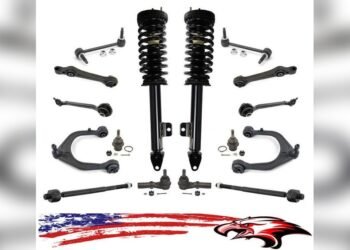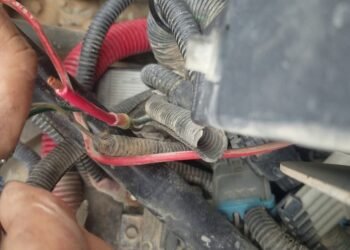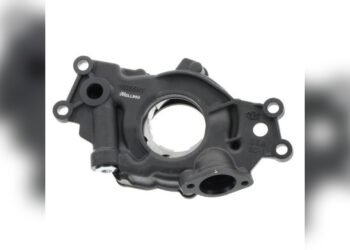Seeing your traction control light on and your car shaking can be alarming. It signals an issue that needs attention.
The traction control system helps keep your car stable, especially on slippery roads. When the light comes on, it means there’s a problem. Your car shaking adds to the concern. This can be due to various reasons, such as tire issues or engine problems.
Understanding these signs can prevent further damage. In this blog post, we will explore the causes and solutions for this issue. So, if your car shows these symptoms, keep reading. We’ll help you understand what’s happening and what to do next.

Credit: www.reddit.com
Common Causes
Experiencing the traction control light on and your car shaking? This can be alarming and inconvenient. There are several common causes for this issue. Understanding them can help you address the problem efficiently.
One of the most frequent causes is sensor malfunction. The traction control system relies on various sensors to monitor the car’s stability and wheel speed. When these sensors fail or become dirty, they can send incorrect signals to the system. This can trigger the traction control light and cause the car to shake.
- Wheel speed sensors monitor the speed of each wheel and ensure they are spinning correctly.
- ABS sensors work with the Anti-lock Braking System to prevent the wheels from locking up.
- Yaw rate sensors measure the car’s rotational speed to detect possible skids.
Cleaning or replacing these sensors can often resolve the problem.
Electrical issues can also cause the traction control light to come on and the car to shake. The traction control system relies heavily on the vehicle’s electrical components. Any disruption can affect its functionality.
Common electrical issues include:
- Faulty wiring: Damaged or corroded wires can disrupt the signals sent to the traction control system.
- Blown fuses: A blown fuse can interrupt the electrical flow, causing system malfunctions.
- Battery problems: A weak or dying battery can cause electrical issues, impacting the traction control system.
Inspecting the vehicle’s wiring, fuses, and battery can help identify and fix these problems.

Credit: www.reddit.com
Diagnosing The Problem
When the traction control light appears and your car starts shaking, it’s a sign that something is wrong. Understanding the root cause of this issue is crucial. Diagnosing the problem involves a few steps and can save time and money. Let’s dive into the methods to identify what’s causing your car to shake.
Using Diagnostic Tools
Modern cars come with sophisticated systems. These systems help in diagnosing issues quickly. One of the most common tools is the OBD-II scanner. This tool plugs into your car’s diagnostic port. It reads data from your car’s computer system. Here’s how you can use it:
- Locate the OBD-II port under the dashboard.
- Plug in the OBD-II scanner.
- Turn on the ignition, but don’t start the engine.
- Read the codes displayed on the scanner.
A table of common OBD-II scanners and their features might be useful:
| Model | Features | Price |
|---|---|---|
| BlueDriver | Bluetooth connectivity, real-time data | $99 |
| FIXD | App integration, maintenance reminders | $59 |
| Autel MaxiCOM | Wide vehicle coverage, advanced diagnostics | $299 |
Identifying Error Codes
Once you have the error codes, it’s time to decode them. Each code corresponds to a specific issue. For example, code P0301 indicates a misfire in cylinder 1. Here’s a list of common error codes related to the traction control system:
- P0300: Random/multiple cylinder misfire detected
- P0301: Cylinder 1 misfire detected
- P0302: Cylinder 2 misfire detected
- P0303: Cylinder 3 misfire detected
Understanding these codes helps pinpoint the exact issue. It could be a bad spark plug, a faulty sensor, or something else. Taking action based on these codes can prevent further damage.
Using these steps, you can diagnose the problem effectively. Knowing what’s wrong is the first step to fixing it. Keep your car running smoothly by addressing issues promptly.
Sensor Issues
Sensor issues can often cause the traction control light to illuminate and your car to shake. Faulty sensors disrupt the vehicle’s stability. This impacts its ability to maintain traction. Let’s explore the key sensors involved.
Wheel Speed Sensors
Wheel speed sensors detect the speed of each wheel. They send this data to the car’s control unit. If a sensor malfunctions, incorrect data is sent. This can confuse the traction control system. As a result, the traction control light may turn on, and the car might shake.
Abs Sensors
ABS sensors monitor the speed of the wheels. They work closely with the traction control system. If these sensors fail, the system might not work properly. This can trigger the traction control light. It can also cause the car to shake, indicating a problem.
Electrical Problems
Electrical problems can cause the traction control light to come on. They can also make your car shake. This can be due to issues in the wiring or faulty connections. Both need to be fixed to get your car running smoothly.
Wiring Problems
Wiring problems can cause many issues in your car. Old or damaged wires may not carry power properly. This can make your car’s systems fail.
Here are some common symptoms:
- Flickering lights on the dashboard
- Car shaking when idle
- Random error messages
Check your car’s wiring if these symptoms occur. Regular checks can help you spot problems early.
Faulty Connections
Faulty connections can also cause electrical issues. Loose or corroded connections can disrupt power flow. This can lead to the traction control light coming on.
Signs of faulty connections include:
- Intermittent power loss
- Dashboard lights flickering
- Car stalling
Inspect and clean connections regularly. This can prevent many electrical issues.
Both wiring problems and faulty connections can cause the traction control light to come on. They can also make your car shake. Addressing these issues can improve your car’s performance.
Mechanical Problems
Mechanical problems can cause the traction control light to turn on. They can also cause your car to shake. Understanding these issues can help you address them quickly. This ensures your vehicle remains safe and reliable.
Engine Misfires
Engine misfires can trigger the traction control light. They can make your car shake. A misfire occurs when one or more cylinders do not fire properly. This disrupts the engine’s smooth operation.
Several factors can cause engine misfires. These include worn spark plugs, faulty ignition coils, and fuel delivery problems. Addressing these issues can stop the shaking and turn off the warning light.
Transmission Issues
Transmission issues can also activate the traction control light. They can lead to noticeable shaking. Problems with gears, sensors, or fluid levels can disrupt transmission function. This can cause the car to shake.
Regular maintenance can prevent transmission issues. Check fluid levels and replace them as needed. This helps keep the transmission working smoothly. It also reduces the risk of the traction control light turning on.
Fixing Sensor Issues
Fixing sensor issues is crucial for a smooth driving experience. Sensors play a key role in the vehicle’s stability and traction control system. When the traction control light comes on and your car shakes, it often indicates a sensor problem. Addressing these issues can significantly improve your vehicle’s performance. Let’s explore two effective methods: cleaning sensors and replacing sensors.
Cleaning Sensors
Dirty sensors can cause inaccurate readings. Cleaning them is a simple and cost-effective solution. Follow these steps to clean your car’s sensors:
- Turn off the car and disconnect the battery.
- Locate the sensors. Refer to your car’s manual if needed.
- Use a clean, dry cloth to wipe away dirt and debris.
- If the sensors are greasy, use a sensor-safe cleaner.
- Reconnect the battery and test the car.
Clean sensors ensure accurate readings. This helps the traction control system function properly.
Replacing Sensors
Sometimes cleaning is not enough. Faulty sensors may need replacement. Here’s how to replace them:
- Buy the correct sensor for your car model.
- Disconnect the battery to avoid electrical hazards.
- Remove the old sensor using appropriate tools.
- Install the new sensor in place.
- Reconnect the battery and start the car.
Replacing sensors can be a bit more challenging. If unsure, consult a mechanic for assistance.
Addressing sensor issues can resolve the traction control light problem. It also helps prevent car shaking, offering a safer ride.
Addressing Electrical Problems
Experiencing a traction control light on and car shaking? This could point to electrical issues affecting vehicle stability. Addressing these problems promptly ensures safety and smooth driving.
Experiencing a traction control light on and your car shaking? It could be due to electrical problems. These issues often stem from faulty wiring or poor connections. Addressing these problems can help restore your vehicle’s smooth performance.Repairing Wiring
Faulty wiring can cause your traction control light to illuminate. Damaged wires may disrupt the signals sent to your car’s systems. Inspect your car’s wiring for any visible damage. Look for frayed wires, exposed metal, or burnt sections. Repairing or replacing damaged wires can resolve the issue.Fixing Connections
Loose or corroded connections can lead to electrical issues. Check all the connections related to the traction control system. Clean any corroded terminals with a wire brush. Tighten any loose connections to ensure proper contact. Secure connections can prevent further electrical problems. “`
Credit: www.reddit.com
When To Seek Professional Help
Experiencing a shaking car and a traction control light can be unsettling. While some issues can be fixed at home, there are times when you need a professional. Let’s explore these situations in detail.
Complex Diagnoses
Sometimes, the cause of the problem isn’t clear. A shaking car with a traction control light can result from several issues. These include:
- ABS system faults
- Transmission problems
- Faulty sensors
Modern cars have complex systems. Diagnosing these issues may require specialized tools and knowledge. A professional mechanic can use diagnostic equipment to pinpoint the exact problem. This ensures that the issue is properly addressed and fixed.
Safety Concerns
Safety should always come first. If your car shakes and the traction control light is on, it could be dangerous. It’s important to understand the risks:
| Issue | Potential Risk |
|---|---|
| Faulty brakes | Reduced stopping power |
| Transmission problems | Loss of control |
| Engine issues | Breakdown |
Driving with these problems can lead to accidents. If you notice any of these signs, seek professional help immediately. Your safety and the safety of others on the road is paramount.
Frequently Asked Questions
What Does It Mean When Traction Control Light Comes On?
The traction control light indicates a problem with your car’s traction system.
Why Is My Car Shaking When The Traction Control Light Is On?
Your car may shake due to issues with the engine or tires. Get it checked.
Can I Drive With The Traction Control Light On?
It’s best to get your car checked. Driving might be unsafe.
How Do You Fix A Traction Control Light?
A mechanic can diagnose and fix the issue. It may involve sensors or wiring.
Is Traction Control Related To Car Shaking?
Yes, they can be related. Both might indicate a problem in the car’s system.
Conclusion
Experiencing a traction control light on and car shaking can be stressful. Addressing the issue quickly ensures your safety. Check for common causes like low tire pressure or worn-out parts. Regular maintenance can prevent many problems. Consult a professional mechanic if the issue persists.
Staying proactive helps keep your car running smoothly. Remember, a well-maintained car enhances your driving experience. Keep an eye on warning lights and unusual car behavior. Taking action early can save you time and money. Safe driving starts with a reliable car.
















